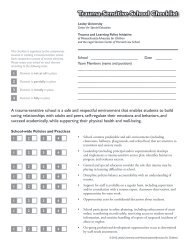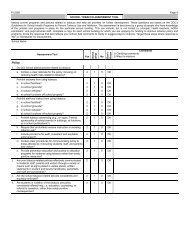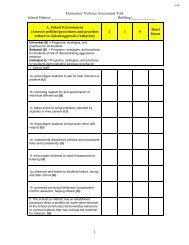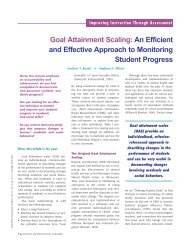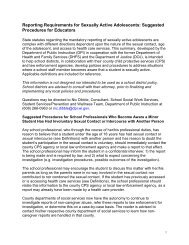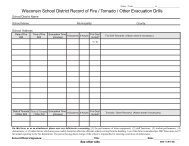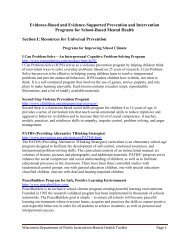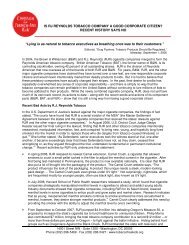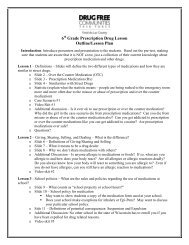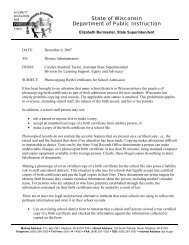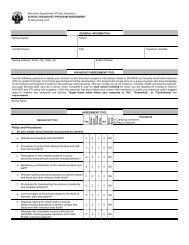Tips for School Tobacco Policy Enforcement - Student Services ...
Tips for School Tobacco Policy Enforcement - Student Services ...
Tips for School Tobacco Policy Enforcement - Student Services ...
You also want an ePaper? Increase the reach of your titles
YUMPU automatically turns print PDFs into web optimized ePapers that Google loves.
TIPS FOR SCHOOL TOBACCO POLICY ENFORCEMENTSeveral common challenges exist in en<strong>for</strong>cingschool policies against tobacco use. Thisdocument describes the challenges, contributingfactors and effective solutions <strong>for</strong> three areas:1. Visitors smoking on school grounds.2. <strong>Student</strong>s using tobacco on school property.3. <strong>Student</strong>s leaving campus to smoke insurrounding neighborhoods.Challenge # 1: Visitors Smoking on<strong>School</strong> GroundsSmoking by visitors on school grounds or atschool-sponsored events is a common challenge.Several factors can contribute to this situation:Lack of awareness. Adult visitors whoviolate the tobacco-free policies usually donot knowingly do so. Many of the tobaccofreeschools policies are new and visitorsmay not be aware of the changes.Difficulties in suppressing the urge to usetobacco at events. Heavy smokers may findit difficult to refrain from smoking <strong>for</strong> anextended period of time – such as at athleticevents or school plays and concerts.However, they can still adhere to schoolpolicy by walking off the grounds to usetobacco. That’s more than what is possibleon most airline flights.Hesitancy to confront violators. <strong>School</strong>district personnel sometimes are hesitant toconfront violators. Some fear that violatorswho are confronted may cause trouble <strong>for</strong>the schools within the larger community.Others feel that "it is not their job" to policeen<strong>for</strong>cement.Solutions to Visitors Smoking on <strong>School</strong>GroundsSolution: Communicating <strong>Policy</strong> EffectivelyTo the community-at-large. Some districtscommunicate their policies by publicizing them inthe local newspapers. Others send notification ofthe policy with "parent packets" at the beginningof the year. Consequences of violation aredescribed along with other school disciplinepolicies. Ongoing reminders are included inparent newsletters throughout the year and/orthrough parent organizations such as PTA, PTOand accountability committees.Communication of policy on-site. Adequatesignage is an essential part of communicatingtobacco-free policies. Some districts liberallyposts signs around campus. If violations continuein a particular building or in an area on schoolgrounds, the placement and visibility of signage inthese areas should be checked to ensure signs areplentiful and visible. Since smoking by visitors atathletic events is the most commonly reportedproblem, it is important to place signs at theentrance to stadiums, in gyms and on bleachers.Be<strong>for</strong>e and during every football game and otherathletic events, staff from some schools makeannouncements over the loudspeaker stating thatthe school is tobacco-free and that smoking orchewing is not allowed on the premises. Theyremind visitors that this policy exists to protect thehealth of students. These same announcementscan be made at plays, concerts, dances and otherschool events. Written event programs alsoprovide an opportunity to convey and rein<strong>for</strong>cetobacco-free policies.Presenting the policy in a positive light.Regardless of the method of communication, themanner in which a policy is presented has aneffect on its acceptance. Some districts emphasize_____________________________________________________________________________________________Adapted with permission from Getting to <strong>Tobacco</strong> Free <strong>School</strong>s: A Trouble Shooting Guide, Colorado Department ofPublic Health and Environment and American Cancer Society, Colorado Division by the Wisconsin Department ofPublic Instruction. August 2001.1
that adhering to the policy is important <strong>for</strong> theexample it sets <strong>for</strong> students. One administrator,who is a smoker herself, said, "Adults whoviolate the policy are asked to respect it becausewe don't want them (kids) to start smoking.Most adults don't want their kids smoking, sothey understand."instances when adults refuse to comply, thevisibility of law en<strong>for</strong>cement may be a usefuldeterrent to violation. Some districts have “policeschool liaison officers” or other law en<strong>for</strong>cementpersonnel as part of their staff. They can monitorgames, not only <strong>for</strong> tobacco use, but also <strong>for</strong> drugand alcohol use, fights, and vandalism.Framing the policy as a children’s health issue isalso effective. "They (adults) want to set anexample <strong>for</strong> kids. Even a few of our boardmembers who smoke are strongly in favor of thepolicy. During meetings, they deliberately gooff campus to smoke." "For the safety and sakeof our kids, this is a tobacco-free environment"is a repeated message in some districts.Solution: Tactfully confronting violatorsIt is almost inevitable that district personnel willneed to remind visitors of the tobacco-freepolicy. Most often when violations occur,visitors are unaware of the policy or have<strong>for</strong>gotten about it. Usually, a gentle verbalreminder or pointing at tobacco-free signage atthe time of the violation is all that is needed.Most people are embarrassed about the violationand are happy to comply with the policy. Oneadministrator asks people to extinguish hiscigarette by stating, "For the sake of ourstudents, we ask that you not smoke on schoolproperty. This is a tobacco-free campus."Another strategy is to hand violators in<strong>for</strong>mationcards that in<strong>for</strong>m them of the district policy. Inthis situation, the person approaching theviolator does not have to say anything.While school personnel initially may fearapproaching violators, the situation rarely isconfrontational. Confrontation of violators neednot necessarily come from school districtpersonnel. <strong>Student</strong>s, parents, and othercommunity members can do so.Solution: Visibility of law en<strong>for</strong>cement personnelin the districtAdult visitor violations of district tobacco-freepolicies usually are unintentional. For those rare_____________________________________________________________________________________________Adapted with permission from Getting to <strong>Tobacco</strong> Free <strong>School</strong>s: A Trouble Shooting Guide, Colorado Department ofPublic Health and Environment and American Cancer Society, Colorado Division by the Wisconsin Department ofPublic Instruction. August 2001.2Challenge #2: <strong>Student</strong>s using tobacco onschool propertyThere may be various reasons why students aresmoking and/or using chew or "spit tobacco"despite the existence of school policies prohibitingtobacco use. They include the following:• Fitting in. The desire to "fit in" often willprompt students to smoke on school grounds• Rebellion. <strong>Student</strong>s also may be violating thepolicy out of rebellion, or a desire tochallenge authority. <strong>Tobacco</strong> is represented asan "adult behavior" in our society, and teensmay perceive tobacco use as a way to asserttheir independence. Un<strong>for</strong>tunately tobacco useoften is a precursor to underage drinking anduse of other drugs such as marijuana andcocaine.• Lax en<strong>for</strong>cement. The problem isexacerbated when districts do not strictlyen<strong>for</strong>ce their tobacco-free policies withstudents. Behavior change is best achievedwhen consequences are immediate andconsistent. Sporadic en<strong>for</strong>cement sends themessage that students can "get away with it"most of the time.• Addiction to nicotine. Nicotine is a highlyaddictive drug. Many teenagers who smokesay they would like to give up smoking. Manymake serious attempts to quit, but fail. Somestudents will risk violating policies to satisfytheir addiction.
Solutions to use of tobacco on schoolproperty by students.Solution: Commitment to En<strong>for</strong>ceA true staff commitment to en<strong>for</strong>cing the policyis essential. <strong>School</strong> personnel reported theattitude that "this is the right thing to do, and weare doing it." The support must come not onlyfrom the superintendent, but also from otheradministrators, board members, teachers, andstaff throughout the district so a united frontexists and kids receive a consistent message.Many district administrators avoid problemsbecause they are consistent in their messagesand their actions with students.Solution: Youth involvement in the developmentand en<strong>for</strong>cement of policiesOne way to help prevent violations is toencourage students to get involved in theprocess. In some schools students not only helpdevelop the policies, they are expected toen<strong>for</strong>ce them. They are expected to show eachother respect and to appropriately confrontunacceptable behavior by fellow students. Someschools have shortened the break betweenclasses as a direct response to students’ requests.They felt the idle time encouraged them to breakthe tobacco policy.Solution: Communicating the tobacco-freepolicy to studentsMethods of Communication. Effective,proactive communication of the tobacco-freepolicy prevents, or at least reduces, the problemof student violation. Many schools use signs tohelp communicate their tobacco-free policy. Thesignage is very helpful <strong>for</strong> policy en<strong>for</strong>cement.In many districts at the beginning of the year,every student receives a handbook that containsa contract detailing the tobacco-free policy. Insome, both the student and his/her parents arerequired to sign and return the contract statingthey have read and understand the policy.tobacco-free policies; nevertheless, violations can_____________________________________________________________________________________________Adapted with permission from Getting to <strong>Tobacco</strong> Free <strong>School</strong>s: A Trouble Shooting Guide, Colorado Department ofPublic Health and Environment and American Cancer Society, Colorado Division by the Wisconsin Department ofPublic Instruction. August 2001.3New student orientations <strong>for</strong> middle school, highschool and transfer students provide a particularlyimportant mechanism <strong>for</strong> conveying tobacco-freepolicies. Proactive communication helps toestablish school norms and reduce the likelihoodof policy violation. <strong>Student</strong> newsletters also canbe used to announce and rein<strong>for</strong>ce studenttobacco-use policies. Communication strategies,such as announcements <strong>for</strong> visitors at athleticevents, also serve to remind students of anexisting tobacco-free policy.Presenting the <strong>Policy</strong> in a Positive Light. Thebenefits of a tobacco-free school to staff andstudents should be part of many communications.Ensuring that the <strong>Policy</strong> Addresses Violations.The tobacco-free policy should be clear andconcise, and it should elaborate not only theexpected behavior, but also the consequences offailure to comply. Each district or schoolestablishes what the specific disciplinary actionswould occur. This was the Legislature’s attempt torecognize that consequences are likely to varybetween and among local districts and schools. Areview of policies indicates that, while mostdistrict policies clearly articulate the "no use”message, often they do not directly address theconsequences of a violation.Solution: Monitoring student behavior on schoolgroundsStaff often monitored hallways as well as schoolgrounds to deter tobacco use. <strong>School</strong>s typicallyhave some sort of monitoring already in placewatching <strong>for</strong> aggressive behavior and truancy,these same monitors watch <strong>for</strong> compliance withthe tobacco policy. When violations do occur,monitors issue citations. Violators then arereprimanded in accordance to the alternative-tosuspensionprotocol detailed below.Solution: Selected Approaches to Discipline <strong>for</strong><strong>Student</strong> ViolatorsPreventive ef<strong>for</strong>ts can help districts avoid orlessen the problem of student violation of
and do occur. Districts employ differentapproaches consistent with district philosophy.disciplinary actions, the student be offeredassistance with cessation if s/he desires.Progressive Discipline. In lieu of immediatesuspension <strong>for</strong> policy violation, many schooldistricts implement progressive disciplineprograms in an ef<strong>for</strong>t to keep students in school.These programs may or may not include aneducational component. The simplestprogressive discipline programs specifyincreasingly stronger actions as the number ofviolations by a particular student mounts. Theremay be a first warning, followed by a parentconference, followed by possibility ofsuspension.Educational Alternatives to Suspension.Educational programs <strong>for</strong> violators, often called“alternative-to-suspension programs,” haveevolved out of the disciplinarian’s wish to keepstudents who have violated policies in school.These programs often are offered in conjunctionwith a progressive discipline plan. And like theprogressive discipline plan, they are intended todelay the more drastic disciplinary action ofsuspension. Most focus on getting compliancewith the school policy, which requires thestudent to manage his/her tobacco use.Typically, they include in<strong>for</strong>mation on thenegative effects of tobacco use and help thestudent examine his/her own use, with the goalof increasing the student’s interest in cessation.Alternative-to-suspension programs are not thesame as tobacco cessation programs.A successful outcome <strong>for</strong> an educationalalternative-to-suspension program would be nofurther policy violation, as opposed to thesuccessful outcome of a cessation program,which is discontinued use of tobacco. Resourcessuch as Alternatives To Suspension from theAmerican Lung Association are available <strong>for</strong>such programs.Other Disciplinary Actions. Some districts haveelected to adopt a “zero-tolerance approach”with student violators. In the case of tobaccofreepolicies, zero tolerance generally refers toimmediate suspension <strong>for</strong> violation. CDC bestpractice guidelines suggest that whatever the_____________________________________________________________________________________________Adapted with permission from Getting to <strong>Tobacco</strong> Free <strong>School</strong>s: A Trouble Shooting Guide, Colorado Department ofPublic Health and Environment and American Cancer Society, Colorado Division by the Wisconsin Department ofPublic Instruction. August 2001.4Solution: Expand district policies to includepossession of tobaccoSome districts decided that they could implementtheir policies more effectively if they includedpossession and have modified their policiesaccordingly.Challenge #3: <strong>Student</strong>s leaving campus tosmoke in surrounding neighborhoods -“hassle” factor <strong>for</strong> neighbors and safetyconcerns <strong>for</strong> school personnelSome school districts do not experience problemswith students using tobacco on school grounds.Rather, they face the challenge of students leavingcampus to smoke or to use "spit tobacco" in thesurrounding neighborhoods. Often students lingeron or around private residential or businessproperty. In turn local residents and businessowners complain of students throwing trash,leaving cigarette butts, trampling shrubbery, andvandalizing their yards and parking areas.Businesses report that "hovering" groups ofteenagers deter other customers from patronizingtheir stores. Businesses and local residentsfrequently blame schools <strong>for</strong> the students'behaviors and hold schools responsible <strong>for</strong> solvingthe problem.Safety is another concern <strong>for</strong> some districts,especially those in urban areas. <strong>Student</strong>s crossbusy streets in places other than at crosswalks,posing a hazard to themselves as well as todrivers.Solutions to <strong>Student</strong>s Leaving <strong>School</strong> Groundsand Smoking in NeighborhoodsSolution: Involve community in decisionmaking/en<strong>for</strong>cementof policiesIncluding the wider community in discussionsabout the implementation of a tobacco-free policy
can be critical in helping to confront the issue ofstudents leaving school grounds to smoke in theneighborhood. Businesses and communityresidents need a <strong>for</strong>um in which to express theirconcerns to school administrators, boardmembers and students. All parties can develop ajoint and mutually agreeable plan to addressproblems.Solution: Closing school campuses so thatstudents do not leave school groundsSome school districts and/or individual schoolshave closed campuses. <strong>Student</strong>s are not allowedto leave school grounds during the day withoutbeing granted a leave of absence <strong>for</strong> differentactivities, such as to attend field trips or to takeclasses off-site. Some administrators withclosed campuses prior report that they never hadto face the problem of students leaving campusto use tobacco. Some report fewer neighborcomplaints and safety problems. In addition,parents have expressed increased feelings ofsecurity knowing that their children are notpermitted to wander freely in adjacentneighborhoods. The acceptance of closedcampuspolicies goes beyond administration andparents, and includes local business people whoreport reduced theft and vandalism problems.One of the perceived barriers to closing campus,particularly in large districts, is lack of indoorfacilities. Districts fear they will not be able toaccommodate all of their students on campusduring lunch hours or class breaks. Somedistricts have dealt with this issue creatively bystaggering lunch hours, the school day, or eventhe school year.Solution: Expand the "reach" of the tobacco freepoliciesSome schools have defined their tobacco-freepolicies more strictly than others schools byextending its policy beyond school propertyboundaries. Such policies prohibit tobacco useon school grounds and off school grounds within"proximity to the school." Proximity is definedas being within view - "if we can see 'em, it's a leaving campus, but that they were leaving in_____________________________________________________________________________________________Adapted with permission from Getting to <strong>Tobacco</strong> Free <strong>School</strong>s: A Trouble Shooting Guide, Colorado Department ofPublic Health and Environment and American Cancer Society, Colorado Division by the Wisconsin Department ofPublic Instruction. August 2001.5problem." This includes arriving at school and/orleaving school. Additionally, students may bebanned from being with anybody who is smokingwithin proximity to the school.One school developed a unique solution to theproblem of students off school grounds. Duringbreaks at the high school, a number of studentsroutinely walked off school property into theadjacent street and surrounding property duringschool breaks. The off-campus crowd of studentsoften smoked, exhibited disruptive behaviors,littered, attracted students from other schools, andincreased the potential <strong>for</strong> gang incidents.Community members became angry about thesituation and went to the parent accountabilitycommittee <strong>for</strong> assistance. Ultimately, the matterwas turned over to the City Manager and CityCouncil to ask <strong>for</strong> their help. In an ef<strong>for</strong>t toincrease the school’s authority to control studentbehavior on adjacent property, the City Councildeeded shared jurisdiction of the street in front ofthe high school to the district as well as to thecity. This action solved some of the en<strong>for</strong>cementproblems that the school experienced previously.Furthermore, the action encouraged staff tomonitor property adjacent to the school, as theywere now “co-owners” of the area.Some districts use the “door-to-door” principle toextend their policies beyond the school ground.This legal principle says that the school isresponsible <strong>for</strong> the student from the time thestudent leaves home in the morning until s/hearrives home in the afternoon. For example,where school personnel are aware of a potentialsafety problem between home and school (e.g., abully, a vicious dog), staff is expected to takeresponsibility and remediate the situation. Thisprinciple of law is used by administrators toaccount <strong>for</strong> policies that control particularbehaviors beyond the school property, as in “inloco parentis.”Solution: Erecting physical barriers that dispersestudentsIn districts with large student populations, theessence of the problem was not that students were
large groups, all at once. It was the large groupof kids that neighbors took notice of and thatcreated a safety hazard as they crossed busystreets during breaks and lunch hours. The packmentality led to fighting, loitering, and "trashingout" business parking lots with pop cans,sandwich wrappers, and cigarette butts.Among various other ef<strong>for</strong>ts, some schools haveerected high chain link fences along that edge oftheir property. Although students might stillclimb over the fence in order to leave campus,most of them avoid the fence and leave thecampus in other directions. Although the fencedid not prevent students from leaving campus, itdispersed them, which can greatly relieve areabusinesses.Solution: Confront the fear of increasedexposure to drugs/gangsIndividuals within some school districts mayassert that prohibiting tobacco use on campusincreases student exposure to and/orinvolvement in drug and gang-related activitytaking place in the streets. The number ofstudents leaving grounds has increased in somedistricts with implementation and en<strong>for</strong>cementof tobacco-free policies, but no districts actuallyhave reported an increase in drug- or gangrelatedactivity among these students as a resultof their leaving campus. In fact, a fewadministrators that strictly en<strong>for</strong>ce their tobaccofreepolicies believe they will eventually see adecrease in drug activity and possibly in gangactivity as well. <strong>Tobacco</strong>, specifically cigarettes,has been called a "gateway drug.” Often,cigarette smoking precedes illicit drug use.Condoning smoking on or near campuses canconvey the message that smoking is acceptable,and they felt they’d be encouraging students tolearn how to smoke from each other.were passed to help alleviate problems withstudents leaving campuses in order to use tobacco.Some city councils have established a boundarythat was designated as a tobacco-free zone.Within this boundary, essentially a 15-squareblockarea encompassing the elementary schooland the high school, tobacco possession or use isprohibited by anyone under the age of 21 years.Resources <strong>for</strong> in<strong>for</strong>mation and assistance onschool tobacco policy:Wisconsin Association of <strong>School</strong> Boards,608-257-2622Wisconsin Department of Public Instruction,800-441-4563American Lung Association of Wisconsin,262-782-7833.<strong>Tobacco</strong> Control Resource Center <strong>for</strong> Wisconsin,www.tobwis.orgFit, Healthy and Ready to Learn: A <strong>School</strong> Health<strong>Policy</strong> Guide. Available from the NationalAssociation of State Boards of Education,703-684-4000.Solution: Youth possession ordinancesSome communities have adopted city ordinancesthat make minors’ possession and/or use oftobacco illegal. In some cases, these ordinances_____________________________________________________________________________________________Adapted with permission from Getting to <strong>Tobacco</strong> Free <strong>School</strong>s: A Trouble Shooting Guide, Colorado Department ofPublic Health and Environment and American Cancer Society, Colorado Division by the Wisconsin Department ofPublic Instruction. August 2001.6



